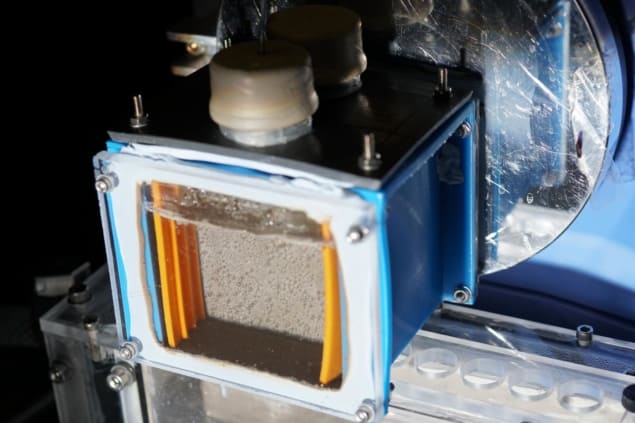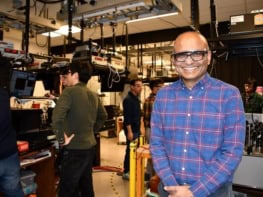
A new photocatalyst sheet that uses light to convert carbon dioxide and water into a useful chemical fuel has been developed by Erwin Reisner and colleagues at the University of Cambridge. The device produces formic acid – a liquid fuel – with very few unwanted byproducts. With improvements to its conversion efficiency, the system could soon make an important contribution towards large-scale, carbon-neutral fuel production.
For billions of years, photosynthesis has provided living cells with an efficient way of using sunlight to convert carbon dioxide and water into chemical fuel. Recently, researchers have made strides towards practical technologies that exploit this process to generate carbon-neutral fuels. So far, however, these devices have often required sacrificial reagents to catalyse the oxidation of water – a key part of the photosynthesis process. This produces unwanted byproducts that need to be separated from the useful fuel, limiting the sustainability of the technology.
In their study, Reisner’s team developed a more sophisticated device that integrates two doped, light-absorbing semiconductor powders that are fixed onto a conductive layer of gold. In addition, a molecular, cobalt-based photocatalyst is embedded into the sheet.
Excess of electrons
When sunlight illuminates the sheet, electron-hole pairs are generated in both semiconductors. One of the semiconductors transfers electrons to the other via the gold layer, leaving behind an excess of positively charged holes. These holes can then be filled by electrons donated by water via an oxidation reaction that was enabled by the photocatalyst. Meanwhile, the excess of electrons in the other semiconductor causes carbon dioxide to undergo a reduction reaction to produce formate. This is a negative ion that can be used to make formic acid, which can be stored as a liquid.
The powders and catalyst comprising the device are easy and inexpensive to produce in large quantities and the role of water as an electron donor eliminates the need for wasteful oxidation-triggering reagents, significantly boosting the sustainability of the process. Although the team’s initial experiments yielded a low solar-to-formate conversion efficiency of just 0.08%, they demonstrated an extremely high formate selectivity of 97±3%, with very few unwanted by-products.

Light-activated catalysts make nearly perfect water-splitters
Reisner and colleagues achieved these results with a sheet area of 20 cm2, but believe it should be relatively easy to scale it up to several square metres – making it suitable for use on commercial solar farms. Since formate is a stable liquid fuel, it can easily be stored and transported, or converted into gaseous hydrogen fuel if necessary. Furthermore, the device is completely wireless and requires no external power, enhancing its sustainability even further.
The researchers will now aim to boost the conversion efficiency of their device to levels suitable for commercialization, by experimenting with a range of different photocatalysts. Through these improvements, the photocatalyst sheet could soon become suitable for practical, large-scale solar fuel production, which actively reduces levels of atmospheric carbon dioxide.
The research is described in Nature Energy.



